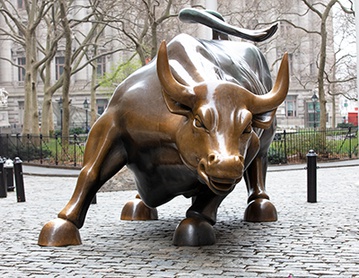To me, the Wall Street Bull signifies several things. First and foremost, it seems like a symbol of male dominance. This is a strong, virile, masculine symbol. There isn't a soft-eyed statue of a doe next to it. This is a stud, a male specimen designed to be the largest, biggest, and best of its kind, and to spread its seed near and far.
A bull this size has one of four purposes: it's either destined for the slaughterhouse, it can be a stud, or it can be in rodeos. Wall Street isn't a rodeo and it isn't a slaughterhouse. These investors want an icon of invincibility. They want to feel like their financial seed will be perpetuated, yielding a cash cow.
Such a male specimen also has implications towards the male chauvinism of the financial world. To me, the Wall Street Bull is a statement that the world of money, investments, and stocks is one that was founded by and belongs to men.
Semiotics #2
When the Olympics and Paralympics were in Salt Lake City, I attended an ice sledge hockey event. It was for men who were either paralyzed from the waist down or who were amputees in one or both of their legs. Their upper body strength and athleticism was amazing to watch.
This picture reflects that. This picture has a lot of implications, just by its nature. Normal track events don't require helmets, so these men must be travelling at incredible speeds at great personal risk. Similarly, you can see the commitment, the intensity, and the strength of these men. Two of those pictured have distinct tattoos. The leader's reads "Mason," who I assume is a son or other close family member. One could surmise that the athletes are not only representing their country, but also proving something to themselves and their families.
One final observation: the stands in the background are blurred, but appear to be packed. These events are not typically as well-attended as regular track-style events. Thus, I'd say that this must be a championship event and that these athletes are representing their country and doing it well.
It's a powerful image of power, passion, intensity, perseverance, strength, and human spirit. Honestly, though, it only means these things to me because I like it. Perhaps that's something that could be said of Semiotics--our likes and dislikes will inherently affect our interpretation of a work.














.png)





















